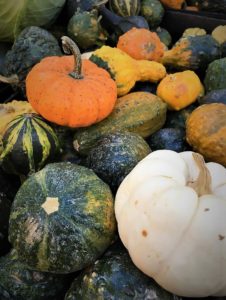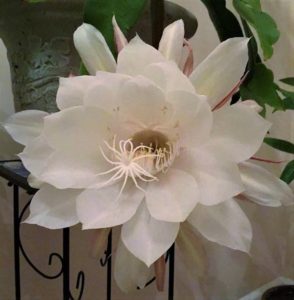I love going to farm stands or greenmarkets in the fall, looking for decorative gourds. Small or large, smooth or lumpy, symmetrical or twisted, colorful or pale, collectively, they showcase the infinite possibilities that nature offers us. Individually, they perk one’s imagination in various ways.
The only gourds that I knew before coming to the States were calabash gourds. (Not to be confused with the fruits of calabash trees.) Imagine butternut squashes in the color of Granny Smith apples. Some of them would have larger and rounder bottoms. Some of them would have two evenly shaped globes. The young fruits are edible. When allowed to mature and dried, their skin turn golden. The hardened shells make them perfect carriers for water or liquor, and hence the name of “bottle gourds.”
The pronunciation of their Chinese name “hulu” (葫蘆) is similar to luck (福) and prosperity (祿). “Hu” also sounds similar to “protection” (護). Therefore, it is believed to have protective power. Bottle-gourd-shape charms are common gifts for newborns and children.
Taoism, which centers around the existence of the universe and the transmutation of space and time, holds bottle gourds in high regards. The two globes of the gourd, representing the heaven and the earth (or, in some interpretation, the sun and the moon), linked by the hollow neck, intermingling with each other—resembling the creation of the universe. In paintings, Taoist immortals often carry a gourd around their waists.
In addition to being carriers of elixirs, bottle gourds are believed to contain healing energy. The idiom 懸壺濟世, meaning “hanging the bottle to bring relief to the world,” is used to describe the charitable actions of medical doctors and appears in acclamatory messages.
Being a symbol of blessing and benevolence, bottle gourds play an important role in Chinese feng shui. Supposedly, hanging them at the right location can bring harmony and good fortune to the household. Nevertheless, my parents probably never thought much about feng shui when they planted gourds near our front windows. They were easy going and fast growing. Their large leaves, covering the pergola, created a green canopy to the front room. The white flowers were simple but pleasant. Gradually, the blossoms transformed into little jade pendant like fruits. We watched these little toys balloon into sizeable squashes. Since we didn’t grow them for food, they would be left to dry on the viens. For years, mom kept the better shaped ones around the house.
I don’t know any symbolism attached to the Western decorative gourds. But, to me, they herald the arrival of a harvest season.

